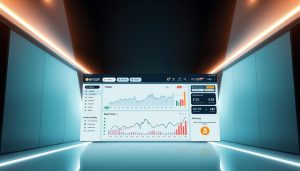Surprising fact: miners pulled roughly $15 billion in revenue in 2021, a scale that makes hardware choices a business decision, not a hobby.
I’ve been hands-on with rigs and hosted setups, and I’ll show you exactly what matters. Expect clear checklists for hardware, efficiency, hash, and power consumption.
Data anchors matter: Compass Mining’s public numbers — multi‑EH/s hashrate under management and uptime guarantees — help set realistic benchmarks for efficiency and operational maturity.
We’ll map U.S. sourcing, vetted marketplaces, and hosted options that actually deliver on time. I’ll also share the tools I use: profitability calculators, dashboards, and pool tips that steady daily revenue.
For deeper market context, see my linked analysis for the latest industry figures and trends: latest market analysis.
Key Takeaways
- Scale matters: $15B revenue shows miners operate at business scale.
- Check efficiency and power consumption, not just hash numbers.
- Prefer vendors with delivery records and clear warranties.
- Hosted options can speed deployment and reduce setup risk.
- Use dashboards and calculators to steady daily cash flow.
Buyer’s overview: how to choose the right mining hardware today
Start with three simple numbers: your cost per kWh, the rig’s J/TH (watts divided by TH/s), and whether your breaker panel can handle the load.
ASICs span a wide price range — roughly $500–$10,000 depending on generation and efficiency. Lower J/TH wins long term. Older models can work if you have cheap energy, but newer rigs give better efficiency per dollar.
- Check real power draw against circuit capacity. Inrush and nameplate variance matter.
- Sort contenders by hash rate and J/TH, then confirm delivery windows and warranty terms.
- Account for noise and heat at your chosen level. Cooling and ventilation are non‑negotiable.
- Spread orders across two batches where possible to guard against shipping slips and batch issues.
“Efficiency and energy are your north stars; hardware hype fades when the bill arrives.”
Make a quick TCO grid: upfront price points, shipping, taxes, PDUs, panel upgrades, and expected energy over 12–24 months. If you’re new to cryptocurrencies and mining, pick proven miners with simple deploys and solid support.
| Example rig | Price range | Efficiency (J/TH) | Power draw (W) |
|---|---|---|---|
| Entry‑level ASIC | $500–$1,500 | 40–60 J/TH | 1,200–1,800 W |
| Mid‑range rig | $1,500–$5,000 | 20–35 J/TH | 2,000–3,400 W |
| High‑efficiency model | $5,000–$10,000 | 8–18 J/TH | 2,500–4,000 W |
Where to buy bitcoin mining machines
Short answer: there are three clear paths—manufacturer direct, vetted marketplaces and hosted providers, and the secondary market—each with tradeoffs I walk through below.
I prefer direct orders from Bitmain Antminer, MicroBT Whatsminer, or Canaan Avalon when I need the cleanest firmware support and best batch pricing. That route often means long lead times, minimum order quantities, and international logistics for each asic miner, so plan shipping and customs ahead.
Vetted marketplaces and hosted providers
Compass Mining and similar services simplify deployment. They supply vetted, high-performance bitcoin miners, deploy them to your chosen pool, and provide a dashboard you can track. Compass lists 5.9 EH/s under management, 20 facilities, 160 MW hosted, a 95% uptime guarantee, 10,000+ customers, and 100,000+ machines sold. For non‑technical buyers this cuts complexity dramatically.
Secondary market and brokers
The secondary market can save capex but raises verification needs. I demand proof‑of‑life videos, serial numbers, control board photos, and timestamped hashrate screenshots. Verify warranty transfer and use escrow or signed invoices when brokers are involved.
“Energy and logistics kill thin margins; proximity to a reliable service desk often beats a small price cut.”
| Source | Pros | Cons |
|---|---|---|
| Direct (Bitmain, MicroBT, Canaan) | Best pricing per batch; official firmware and warranty | Long lead times; MOQs; import logistics |
| Vetted marketplaces / Hosting (Compass) | Simple onboarding; deployment to chosen pool; dashboard tracking | Higher upfront fee; less hands-on control |
| Secondary / Brokers | Lower immediate cost; fast delivery for mixed lots | Higher verification burden; warranty risks |
Practical rule: start with one or two rigs through a reputable marketplace, track hashrate and power use, then scale. Ask sellers for a clear service number and ticket SLAs before signing.
How to evaluate miners: efficiency, power consumption, and reliability
The single metric I trust most is joules per terahash; it frames every other choice. Energy efficiency (J/TH) is watts divided by terahash per second. Lower J/TH means lower running costs and better ROI.
Energy efficiency (J/TH): why lower is better for ROI
Rank by J/TH first. A 2–5 J/TH edge compounds into real dollar savings over 12 months at scale. For example, recent models like the S19 XP (~21.5 J/TH) show clear gains over older rigs.
Power consumption, circuits, and site readiness
Translate the spec sheet into continuous wall draw, voltage, and amperage. Confirm breaker size, wire gauge, and outlet type so the rig runs safely under sustained load.
At site scale, run a load study. Under‑spec transformers or distribution gear cause brownouts and downtime that destroy margins.
Noise and cooling: air, hydro, and immersion considerations
Air‑cooled units are noisy; plan enclosures or baffles. Hydro and immersion cut noise and stabilize temps but add pumps, fluids, and maintenance.
Manufacturer reputation and model track records
I treat bitmain antminer, Whatsminer, and Avalon as distinct reliability profiles. S9s proved durable; some S17/T17 batches had elevated failure rates (20–30% early failures).
“Efficiency drives operating cost; small gains scale into big savings.”
- Validate firmware and control board versions; tweaks affect fan curves and power draw.
- Track your 30‑day average hash rate in pool records — paper specs lie until proven.
- Keep a punch list: thermal pads, PSU checks, fan RPM, weekly visual inspections.
Hosting vs self-managing: matching your budget, expertise, and goals
Hosting can cut setup time from weeks to hours, and that speed often saves more than the fee.
I go hosted when I want predictable uptime and fast deployment. Compass Mining’s scale—5.9 EH/s under management, 20 facilities, 160 MW, and a 95% uptime guarantee—buys staffing and bulk power advantages most DIY setups can’t match.
Self-managing shines if you have cheap power and hands-on skills. You keep control of the rig, pick the pool strategy, and can shave costs if your site is efficient.
For non-technical buyers, service levels and monitoring matter most. Hosted miners deploy to your chosen pool and show hashrate and alerts in a dashboard. That peace of mind often offsets fees.
“Place one unit in hosting and one at home; compare net outputs after 60 days and let the data decide.”
| Option | Key advantage | When it wins |
|---|---|---|
| Hosting (Compass) | Fast deployment, staffing, SLA credits | Limited time, prefers predictable uptime |
| Self-manage | Full control, potential lower OpEx | Low-cost power and hands-on ops |
| Hybrid | Split risk, direct cost comparison | Testing strategy or mixed scale |
Practical tip: compare contracts line by line—uptime mechanics, curtailment, swap timelines. Monitor hashrate, temperature, and power draws closely. The math will tell you which path wins.
Tools you’ll need to compare miners and plan operations
Before ordering any rig, assemble the calculators and dashboards you’ll actually use daily. Good tools turn specs into testable assumptions. They reduce guesswork and keep margins intact.
Mining profitability calculator
Inputs matter: enter hashrate, watts, and local electricity costs. Then vary difficulty and price to stress-test ROI.
Performance dashboards
Use a dashboard (hosted or self-hosted) to track hashes per second, average versus current hashrate, temps, and uptime. Set alerts so a failed fan wakes you at 2 a.m. rather than costing weeks of revenue.
Pools and mining software
I prefer mature Stratum endpoints for steady payouts and use P2Pool when I need decentralization. Confirm your mining software supports the coin algorithm before spinning up any rig.
- Log first 72 hours per second of operation; early drift flags PSUs and boards.
- Track firmware changes—small efficiency wins add up.
- Keep a spreadsheet of each rig: serial, IP, circuit, and PDU port.
| Tool | Primary use | Key input |
|---|---|---|
| Profitability calculator | Estimate revenue & breakeven | Hashrate, watts, electricity costs |
| Performance dashboard | Monitor uptime and temps | Hashes per second, alerts |
| Pool endpoints / software | Secure steady payouts | Stratum or P2Pool, algorithm support |
Practical note: request API or read‑only dashboard access if hosted; your export history is your best audit trail.
Graph and statistics: efficiency and hashrate trends that impact buying
A simple visual is the fastest check I run before ordering any hardware. I plot J/TH by release date and then layer network power. The pattern tells you how long a rig will stay competitive.
ASIC efficiency over time (J/TH)
Think of the line dropping from early S9 days through S17 and S19 to the newer S21‑class. Each generation cuts energy per trillion hashes and widens margins at similar wall draw.
Network hashrate growth and miner revenue
Key stats: network hashrate rose into millions of terahashes per second while miner revenue reached about $15B in 2021 (The Block).
The takeaway: rising competition forces higher efficiency. I assume difficulty climbs over 6–12 months and pace orders accordingly.
“If a seller claims an outlier efficiency, I ask for independent at‑the‑wall tests before I sign.”
| Metric | Trend | Impact |
|---|---|---|
| J/TH | Falling across generations | Longer rig viability |
| Network hashrate | Rising | Higher difficulty, lower per‑rig yield |
| Revenue | Large sector (~$15B in 2021) | Arms race for efficiency |
Cost, price points, and calculating return on investment
I start every purchase by splitting immediate spend from ongoing costs. That simple split shapes realistic ROI and keeps surprises small.
CapEx vs OpEx
CapEx covers rigs, machine shipping, PDUs, wiring, and site upgrades. ASICs often fall in a range of $500–$10,000 depending on model and efficiency.
OpEx includes electricity costs, maintenance parts, facility rent, insurance, staff, and pool fees.
Break-even math and practical rules
Run three scenarios: base, optimistic, conservative. Change difficulty, hash rate, and price to see how return investment shifts.
- Include delivery lead times; downtime means no hash and delayed revenue.
- Important note: reserve for fans, PSUs, and board failures.
- Annualize hosting fees against local power; sometimes a less efficient miner wins on uptime.
“Discipline beats hope: set a stop‑loss if OpEx outpaces revenue for X days.”
| Cost bucket | Examples | Typical impact |
|---|---|---|
| CapEx | rig, shipping, PDUs | Upfront cash, affects breakeven |
| OpEx | electricity costs, maintenance, pool fee | Monthly drain, long‑term ROI |
| Risk | lead times, downtime | Delays reduce effective hashes per period |
Evidence-based picks: matching rigs to your energy and facility profile
Match your site power profile with rigs that deliver steady hash under real load, not peak specs.
I favor high-efficiency units if your power is average. Models in the Antminer S21 class and MicroBT Whatsminer M60 series show clear gains in J/TH.
High-efficiency ASIC choices
Why they matter: lower energy per hash widens margin and reduces heat. For many sites a single efficient asic miner beats two older units after power consumption and downtime are counted.
When older models still work
If you have very cheap power and solid airflow, older rigs can still pencil out. Factor higher failure rates, louder noise, and extra maintenance time into your plan.
- If power is average: shortlist S21 or M60-series for efficiency and warranty backing.
- Cheap power: older rigs can save capex but raise service burden.
- Small sites: one efficient miner often outperforms two noisy rigs after total cost.
“Validate claimed efficiency with at‑the‑wall readings and uptime screenshots before funds leave your account.”
| Profile | Recommended | Key risk |
|---|---|---|
| Average power | Antminer S21 / M60 | Lead times, cost |
| Cheap power | Older generation rigs | Noise, failures |
| Small site | Single high-efficiency unit | Initial capex |
Sources and proof: data that informs this buyer’s guide
Proof matters — not slogans — so I lean on published metrics and at‑the‑wall tests. I cite numbers that can be tracked and audited, not marketing lines. That means dashboards, uptime logs, and vendor receipts.
Compass Mining provides a useful benchmark: 5.9 EH/s under management, 20 hosting facilities, 160 MW hosted, and a 95% uptime guarantee backed by service credits. Their public counts — 10,000+ customers and 100,000+ machines sold — show what scaled hosting looks like in the U.S.
I pair that with industry research. The Block reported roughly $15B in miner revenue for 2021, which explains why capital chases efficiency gains. Documented J/TH drops from early models through the S19 and S21 era validate the guide’s focus on lower watts per terahash.
Operational proof is non‑negotiable. Confirm that a host will deploy your rig to your chosen pool and provide dashboard monitoring. Ask how credits are calculated, swap timelines, and whether an asic miner or a bitmain antminer is swapped under warranty.
- Request at‑the‑wall hashrate screenshots and multi‑day averages.
- Verify serials, firmware versions, and timestamped uptime logs.
- Run the same mining software and compare outputs before scaling.
“Numbers, not narratives: if a claim lacks an independent source, flag it and move on.”
| Source | Key metric | Why it matters |
|---|---|---|
| Compass Mining | 5.9 EH/s; 160 MW; 95% uptime | Benchmarks hosted scale and SLA mechanics |
| The Block | $15B miner revenue (2021) | Shows capital flow driving efficiency |
| Manufacturer specs | J/TH improvements across generations | Validates energy and efficiency focus |
Predictions and guidance for buyers in the present market
The present market rewards disciplined buyers who match rig choices with real site constraints, not marketing slides. Expect steady, measurable shifts rather than a single leap. Small gains in efficiency and smarter cooling will set winners apart this year.
Short-term outlook: efficiency gains and immersion/hydro adoption
Short term: modest efficiency improvements will arrive, and more operators will try immersion or hydro cooling as floor density climbs. Those systems cut thermal overhead and often improve sustained hash stability.
Immersion has real capex: tanks, pumps, and heat rejection gear. It also reduces noise and frees floor level for denser racks. Expect firmware updates to squeeze extra efficiency before any big hardware shift.
U.S. considerations: power contracts, hosting, and rules
Hosting capacity will tighten in pockets. If you plan to scale, book space early and verify physical rack or cage measurements rather than verbal promises.
Power contracts and curtailment clauses are the swing factors in the U.S. Read seasonal terms closely so shutdown days don’t surprise you after deployment.
“Important note: regulators watch noise and energy footprints — check local rules before you mine bitcoin at home or expand a warehouse.”
- Site level: invest in airflow and filtration now. Each degree you drop helps protect hardware life and steady hash.
- Spare parts: keep fans, PSUs, and control boards on hand; shipping lags turn small faults into multi‑week downtime.
- Diversify: spread rigs across providers or locations where possible to hedge power or policy shocks.
- Discipline: buy efficient units, deploy fast, monitor daily, and avoid speculative preorders that often slip.
Conclusion
Conclusion
Keep the math and the room climate front and center; they decide if a rig pays back. A mining rig’s ROI hinges on J/TH, local power, uptime, and delivery lag. I focus on measured wall reads and week‑long dashboard averages before I scale.
Choose direct orders for control, vetted marketplaces or hosted providers for speed, and brokers only for gaps. Verify serials, proof‑of‑life, and warranty terms before funds move.
For people who want to mine bitcoin without loud noise or rewiring, hosted racks or enclosure builds work. Update mining software, pick a steady pool, and log hashes per second so surprises are rare.
Final thought: buy fewer, better rigs; deploy them cleanly; keep spares and monitor daily. Data beats hype every time.










 Bitcoin
Bitcoin  Ethereum
Ethereum  Tether
Tether  XRP
XRP  Solana
Solana  USDC
USDC  Lido Staked Ether
Lido Staked Ether  TRON
TRON  Dogecoin
Dogecoin